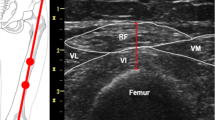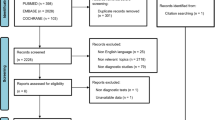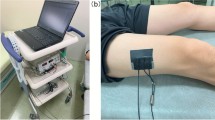Abstract
Background
Accelerated muscle wasting still represents a major issue in critically ill patients. However, a key problem in the intensive care unit is the lack of adequate tools for bedside evaluation of muscle mass. Moreover, when acute kidney injury (AKI) coexists, fluid overload and/or rapid fluid shifts due to renal replacement therapies that frequently occur and may interfere with muscle mass assessment. The purpose of this study is to validate muscle ultrasound (US) by a gold standard (muscle CT scan) for the assessment of quadriceps muscle thickness in critically ill patients with AKI.
Methods
Quadriceps rectus femoris thickness and quadriceps vastus intermedius thickness of critically ill patients with AKI were blindly assessed at the same leg sites by both US and computed tomography (CT) scan. Using bivariate mixed-model linear regression analysis, we estimated, average difference in thickness between measurement sites, agreement (differential and proportional bias) of US compared to CT, and precision of the two methods, and eventually performed Bland–Altman analysis for repeated measurements on pooled results.
Results
We analyzed 233 couples of measurements (30 patients). Average muscle thickness ranged between 1.0 and 1.6, depending on the measurement site. When comparing US to CT, both the observed differential bias (between + 0.04 and + 0.26 cm depending on the muscle site) and the proportional bias (between 82 and 98% of the reference values, depending on the muscle site) were not statistically significant. However, precision analysis showed that US scan tended to be slightly less precise in comparison to CT. Bland–Altman analysis on pooled results showed that the 95% limits of agreement between the US and CT were narrow, ranging from − 0.34 to + 0.36 cm.
Conclusion
In critically ill patients with AKI, quadriceps muscle thickness assessment based on US is unbiased, although it occurs with a minor loss of precision compared to CT.




Similar content being viewed by others
References
Puthucheary ZA, Rawal J, McPhail M, Connolly B, Ratnayake G, Chan P, Hopkinson NS, Phadke R, Dew T, Sidhu PS, Velloso C, Seymour J, Agley CC, Selby A, Limb M, Edwards LM, Smith K, Rowlerson A, Rennie MJ, Moxham J, Harridge SD, Hart N, Montgomery HE (2013) Acute skeletal muscle wasting in critical illness. JAMA 310(15):1591–1600. https://doi.org/10.1001/jama.2013.278481
Koukourikos K, Tsaloglidou A, Kourkouta L (2014) Muscle atrophy in intensive care unit patients. Acta Inform Med 22(6):406–410. https://doi.org/10.5455/aim.2014.22.406-410
Singer P, Blaser AR, Berger MM, Alhazzani W, Calder PC, Casaer MP, Hiesmayr M, Mayer K, Montejo JC, Pichard C, Preiser JC, van Zanten ARH, Oczkowski S, Szczeklik W, Bischoff SC (2019) ESPEN guideline on clinical nutrition in the intensive care unit. Clin Nutr 38(1):48–79. https://doi.org/10.1016/j.clnu.2018.08.037
Puthucheary Z, Montgomery H, Moxham J, Harridge S, Hart N (2010) Structure to function: muscle failure in critically ill patients. J Physiol 588(23):4641–4648. https://doi.org/10.1113/jphysiol.2010.197632
Na A, O’Brien JM Jr, Hoffmann SP, Phillips G, Garland A, Finley JC, Almoosa K, Hejal R, Wolf KM, Lemeshow S, Connors AF Jr, Marsh CB (2008) Acquired weakness, handgrip strength, and mortality in critically ill patients. Am J Respir Crit Care Med 178(3):261–268. https://doi.org/10.1164/rccm.200712-1829OC
Hiesmayr M (2012) Nutrition risk assessment in the ICU. Curr Opin Clin Nutr Metab Care 15(2):174–180. https://doi.org/10.1097/MCO.0b013e328350767e
Wieske L, Dettling-Ihnenfeldt DS, Verhamme C, Nollet F, van Schaik IN, Schultz MJ, Horn J, van der Schaaf M (2015) Impact of ICU-acquired weakness on post-ICU physical functioning: a follow-up study. Crit Care 19:196. https://doi.org/10.1186/s13054-015-0937-2
Puthucheary ZA, Hart N (2014) Skeletal muscle mass and mortality—but what about functional outcome? Crit Care 18(1):110. https://doi.org/10.1186/cc13729
Weijs PJ, Looijaard WG, Dekker IM, Stapel SN, Girbes AR, Oudemans-van Straaten HM, Beishuizen A (2014) Low skeletal muscle area is a risk factor for mortality in mechanically ventilated critically ill patients. Crit Care 18(2):R12. https://doi.org/10.1186/cc13189
Fiaccadori E, Regolisti G, Maggiore U (2013) Specialized nutritional support interventions in critically ill patients on renal replacement therapy. Curr Opin Clin Nutr Metab Care 16(2):217–224. https://doi.org/10.1097/MCO.0b013e32835c20b0
Sykes L, Nipah R, Kalra P, Green D (2018) A narrative review of the impact of interventions in acute kidney injury. J Nephrol 31(4):523–535. https://doi.org/10.1007/s40620-017-0454-2
Fani F, Regolisti G, Delsante M, Cantaluppi V, Castellano G, Gesualdo L, Villa G, Fiaccadori E (2018) Recent advances in the pathogenetic mechanisms of sepsis-associated acute kidney injury. J Nephrol 31(3):351–359. https://doi.org/10.1007/s40620-017-0452-4
Buckinx F, Landi F, Cesari M, Fielding RA, Visser M, Engelke K, Maggi S, Dennison E, Al-Daghri NM, Allepaerts S, Bauer J, Bautmans I, Brandi ML, Bruyere O, Cederholm T, Cerreta F, Cherubini A, Cooper C, Cruz-Jentoft A, McCloskey E, Dawson-Hughes B, Kaufman JM, Laslop A, Petermans J, Reginster JY, Rizzoli R, Robinson S, Rolland Y, Rueda R, Vellas B, Kanis JA (2018) Pitfalls in the measurement of muscle mass: a need for a reference standard. J Cachexia Sarcopenia Muscle 9(2):269–278. https://doi.org/10.1002/jcsm.12268
Connolly B, MacBean V, Crowley C, Lunt A, Moxham J, Rafferty GF, Hart N (2015) Ultrasound for the assessment of peripheral skeletal muscle architecture in critical illness: a systematic review. Crit Care Med 43(4):897–905. https://doi.org/10.1097/CCM.0000000000000821
Sabatino A, Regolisti G, Bozzoli L, Fani F, Antoniotti R, Maggiore U, Fiaccadori E (2017) Reliability of bedside ultrasound for measurement of quadriceps muscle thickness in critically ill patients with acute kidney injury. Clin Nutr 36(6):1710–1715. https://doi.org/10.1016/j.clnu.2016.09.029
Sabatino A, Regolisti G, Delsante M, Di Motta T, Cantarelli C, Pioli S, Grassi G, Batini V, Gregorini M, Fiaccadori E (2019) Noninvasive evaluation of muscle mass by ultrasonography of quadriceps femoris muscle in end-stage renal disease patients on hemodialysis. Clin Nutr 38(3):1232–1239. https://doi.org/10.1016/j.clnu.2018.05.004
Kidney Disease: Improvig Global Outcomes (2012) KDIGO clinical practice guideline for acute kidney injury. Kidney Int Suppl 2:1–138
Bossuyt PM, Reitsma JB, Bruns DE, Gatsonis CA, Glasziou PP, Irwig L, Lijmer JG, Moher D, Rennie D, de Vet HC, Kressel HY, Rifai N, Golub RM, Altman DG, Hooft L, Korevaar DA, Cohen JF, STARD Group (2015) STARD 2015: an updated list of essential items for reporting diagnostic accuracy studies. BMJ 351:h5527. https://doi.org/10.1136/bmj.h5527
Tillquist M, Kutsogiannis DJ, Wischmeyer PE, Kummerlen C, Leung R, Stollery D, Karvellas CJ, Preiser JC, Bird N, Kozar R, Heyland DK (2014) Bedside ultrasound is a practical and reliable measurement tool for assessing quadriceps muscle layer thickness. JPEN J Parenter Enteral Nutr 38(7):886–890. https://doi.org/10.1177/0148607113501327
Bland JM, Altman DG (1986) Statistical methods for assessing agreement between two methods of clinical measurement. Lancet (London, England) 1(8476):307–310
Taffe P (2018) Effective plots to assess bias and precision in method comparison studies. Stat Methods Med Res 27(6):1650–1660. https://doi.org/10.1177/0962280216666667
Taffé P, Peng M, Stagg V, Williamson T (2017) biasplot: a package to effective plots to assess bias and precision in method comparison studies. Stata J 17(1):208–221
Bland JM, Altman DG (2007) Agreement between methods of measurement with multiple observations per individual. J Biopharm Stat 17(4):571–582. https://doi.org/10.1080/10543400701329422
Thomaes T, Thomis M, Onkelinx S, Coudyzer W, Cornelissen V, Vanhees L (2012) Reliability and validity of the ultrasound technique to measure the rectus femoris muscle diameter in older CAD-patients. BMC Med Imaging 12:7. https://doi.org/10.1186/1471-2342-12-7
Seymour JM, Ward K, Sidhu PS, Puthucheary Z, Steier J, Jolley CJ, Rafferty G, Polkey MI, Moxham J (2009) Ultrasound measurement of rectus femoris cross-sectional area and the relationship with quadriceps strength in COPD. Thorax 64(5):418–423. https://doi.org/10.1136/thx.2008.103986
Souza VA, Oliveira D, Cupolilo EN, Miranda CS, Colugnati FAB, Mansur HN, Fernandes N, Bastos MG (2018) Rectus femoris muscle mass evaluation by ultrasound: facilitating sarcopenia diagnosis in pre-dialysis chronic kidney disease stages. Clinics (Sao Paulo, Brazil) 73:e392. https://doi.org/10.6061/clinics/2018/e392
Bemben MG (2002) Use of diagnostic ultrasound for assessing muscle size. J Strength Cond Res 16(1):103–108
Reeves ND, Maganaris CN, Narici MV (2004) Ultrasonographic assessment of human skeletal muscle size. Eur J Appl Physiol 91(1):116–118. https://doi.org/10.1007/s00421-003-0961-9
Arbeille P, Kerbeci P, Capri A, Dannaud C, Trappe SW, Trappe TA (2009) Quantification of muscle volume by echography: comparison with MRI data on subjects in long-term bed rest. Ultrasound Med Biol 35(7):1092–1097. https://doi.org/10.1016/j.ultrasmedbio.2009.01.004
Menon MK, Houchen L, Harrison S, Singh SJ, Morgan MD, Steiner MC (2012) Ultrasound assessment of lower limb muscle mass in response to resistance training in COPD. Respir Res 13:119. https://doi.org/10.1186/1465-9921-13-119
Parry SM, El-Ansary D, Cartwright MS, Sarwal A, Berney S, Koopman R, Annoni R, Puthucheary Z, Gordon IR, Morris PE, Denehy L (2015) Ultrasonography in the intensive care setting can be used to detect changes in the quality and quantity of muscle and is related to muscle strength and function. J Crit Care 30 (5):1151 e1159–1114. https://doi.org/10.1016/j.jcrc.2015.05.024
Segers J, Hermans G, Charususin N, Fivez T, Vanhorebeek I, Van den Berghe G, Gosselink R (2015) Assessment of quadriceps muscle mass with ultrasound in critically ill patients: intra- and inter-observer agreement and sensitivity. Intensive Care Med 41(3):562–563. https://doi.org/10.1007/s00134-015-3668-6
Mueller N, Murthy S, Tainter CR, Lee J, Riddell K, Fintelmann FJ, Grabitz SD, Timm FP, Levi B, Kurth T, Eikermann M (2016) Can sarcopenia quantified by ultrasound of the rectus femoris muscle predict adverse outcome of surgical intensive care unit patients as well as frailty? A prospective, observational cohort study. Ann Surg 264(6):1116–1124. https://doi.org/10.1097/SLA.0000000000001546
Landi F, Camprubi-Robles M, Bear DE, Cederholm T, Malafarina V, Welch AA, Cruz-Jentoft AJ (2018) Muscle loss: the new malnutrition challenge in clinical practice. Clin Nutr. https://doi.org/10.1016/j.clnu.2018.11.021
Greening NJ, Harvey-Dunstan TC, Chaplin EJ, Vincent EE, Morgan MD, Singh SJ, Steiner MC (2015) Bedside assessment of quadriceps muscle by ultrasound after admission for acute exacerbations of chronic respiratory disease. Am J Respir Crit Care Med 192(7):810–816. https://doi.org/10.1164/rccm.201503-0535OC
Acknowledgements
AS is the recipient of a young investigator research grant by the Italian Society of Artificial Nutrition and Metabolism (Società Italiana di Nutrizione Artificiale e Metabolismo, SINPE) for the project: “Valutazione dello stato nutrizionale nell’insufficienza renale mediante ecografia del muscolo quadricipite femorale” (“Nutritional assessment of patients with chronic kidney disease and acute kidney injury by ultrasound of the quadriceps femoris muscle”).
Funding
This work was supported in part by the Italian Society of Artificial Nutrition and Metabolism (Società Italiana di Nutrizione Artificiale e Metabolismo, SINPE).
Author information
Authors and Affiliations
Corresponding author
Ethics declarations
Conflict of interest
The authors declare that they have no conflict of interest.
Statement of authorship
All persons who meet authorship criteria are listed as authors, and all authors certify that they have participated sufficiently in the work to take public responsibility for the content, including participation in the concept, design, analysis, writing, or revision of the manuscript.
Ethical approval
All procedures performed in studies involving human participants were in accordance with the ethical standards of the regional research committee AVEN (authorization 9713 of March 14, 2017), and with the 1964 Helsinki Declaration and its later amendments or comparable ethical standards.
Additional information
Publisher's Note
Springer Nature remains neutral with regard to jurisdictional claims in published maps and institutional affiliations.
Electronic supplementary material
Below is the link to the electronic supplementary material.
40620_2019_659_MOESM1_ESM.tif
Online resource 1. Muscle thickness measured by ultrasound (in cm). QRFT, Quadriceps rectus femoris thickness; QVIT, Quadriceps vastus intermedius thickness. (TIFF 974 kb)
Rights and permissions
About this article
Cite this article
Sabatino, A., Regolisti, G., di Mario, F. et al. Validation by CT scan of quadriceps muscle thickness measurement by ultrasound in acute kidney injury. J Nephrol 33, 109–117 (2020). https://doi.org/10.1007/s40620-019-00659-2
Received:
Accepted:
Published:
Issue Date:
DOI: https://doi.org/10.1007/s40620-019-00659-2




